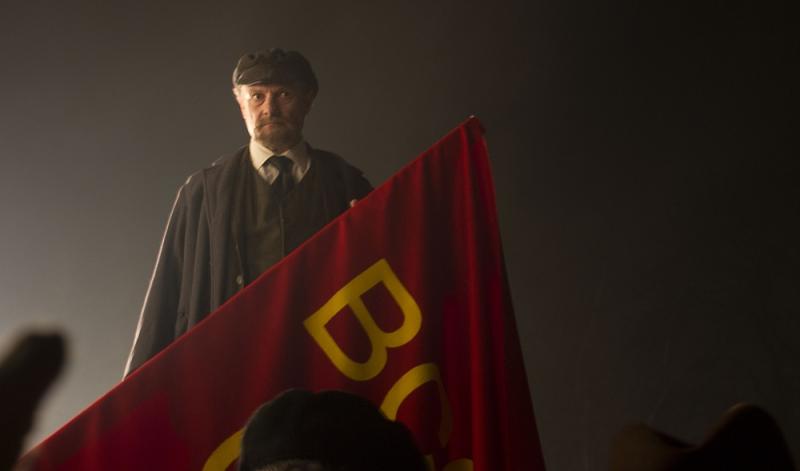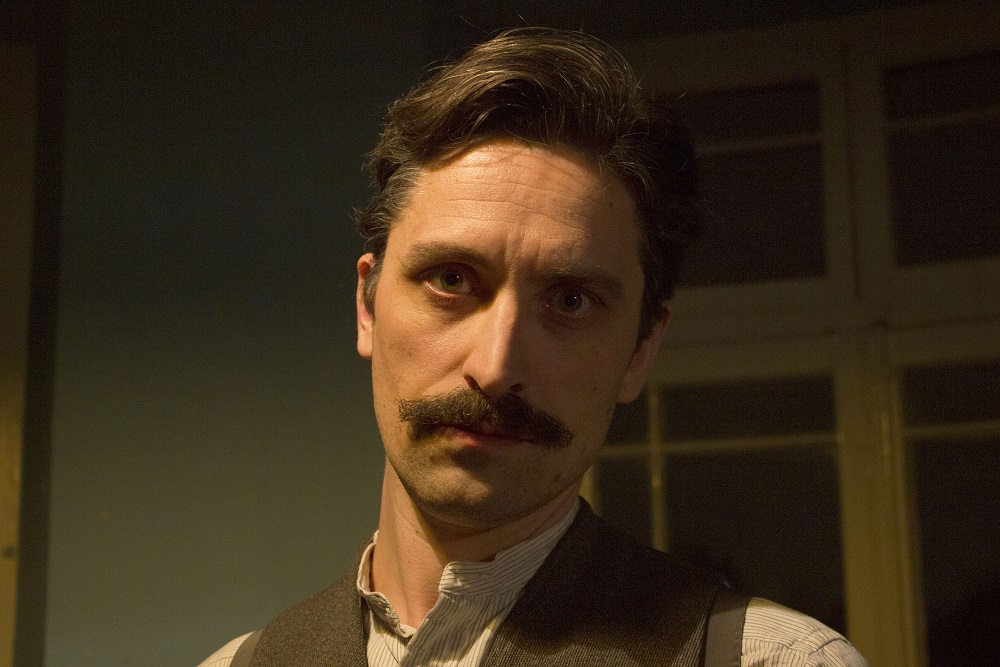Russia 1917: Countdown to Revolution, BBC Two review - words stronger than pictures 100 years on | reviews, news & interviews
Russia 1917: Countdown to Revolution, BBC Two review - words stronger than pictures 100 years on
Russia 1917: Countdown to Revolution, BBC Two review - words stronger than pictures 100 years on
Historians compete to tell their version of events, while dramatic reconstructions add little

It’s getting to that time of the century. A hundred years ago to the month, if not quite the day, the Winter Palace was stormed, and the Russian Revolution came to pass.
A battalion of historians answered the summons to give their version of events, the types whose titles are prominently displayed in airports and beyond. Indeed, if you lobbed a Molotov cocktail into the documentary's green room you’d severely deplete the UK’s stock of Stalin fanboys. And boys they mainly were. Saving the presence of Helen Rappaport and Bridget Kendall, this retelling of the October revolution boiled down to a face-off between Simon Sebag Montefiore and Orlando Figes with wry asides from Victor Sebestyen.
Savoury storytellers, they were the ones entrusted with the business of narrating the events on the crucial day, and the edit cut between them as if at a game of communist historian ping pong. "It was the first Bolshevik lie," said Sebestyen as Trotsky's oratorical enthusiasm got the better of him and he prematurely claimed Kerensky's provisional government had fallen. Figes described Lenin, back from exile and disguised by bandages, mumbling his way past the guards as he headed for the Smolny Institute where the revolution was hatched: “This is the one moment when one man makes all the difference,” he posited. Sebag Montefiore placed us at Lenin’s elbow in Room 36. “These series of shambolic rooms, half encampment, half military headquarters, half student bivouac, are the centre of the world.” That’s a lot of halves, but then this was a confusing time.
 As ever with history from before the age of film, some of the budget went on actors tearing their hair and giving rousing speeches to empty rooms. “Haven’t you heard there’s been a revolution?” someone told Lenin in a drawing room. “I’ve heard this sort of rumour before. It’s probably German propaganda.” And he took another sip of tea. It’s high time documentaries dreamed up ways to bring history to life that don’t insult our intelligence, though Stalin (pictured above, Nick Cowell) would have been chuffed to note he’d grown about a foot. (A similar thing happened in a Mozart drama-doc a few years ago when little Wolfgang was played by a basketball player.) More evocatively, Eisenstein’s reconstruction of the seismic events, shot a decade later as a building block in the USSR’s creation story, was liberally sprinkled through the action, even though it rather multiplied the number of revolutionaries storming the Winter Palace.
As ever with history from before the age of film, some of the budget went on actors tearing their hair and giving rousing speeches to empty rooms. “Haven’t you heard there’s been a revolution?” someone told Lenin in a drawing room. “I’ve heard this sort of rumour before. It’s probably German propaganda.” And he took another sip of tea. It’s high time documentaries dreamed up ways to bring history to life that don’t insult our intelligence, though Stalin (pictured above, Nick Cowell) would have been chuffed to note he’d grown about a foot. (A similar thing happened in a Mozart drama-doc a few years ago when little Wolfgang was played by a basketball player.) More evocatively, Eisenstein’s reconstruction of the seismic events, shot a decade later as a building block in the USSR’s creation story, was liberally sprinkled through the action, even though it rather multiplied the number of revolutionaries storming the Winter Palace.
The other source of entertainment was watching historians disagree with one another. Was the revolution a coup d’état? Yes if you ask Kendall. All perfectly legit, according to Tariq Ali, the leftie firebrand who wasn't to be drawn on Lenin's project to set up a one-party dictatorship which killed thousands. Martin Amis, not being a narrative historian, was underused, but could be relied upon for a lapidary overview. “When the ideologue is confronted with reality that doesn’t fit into his scheme,” he explained, “he can’t defeat reality with argument, so the fist tightens.”
It’s still tight: a brief coda considered communism’s contemporary legacy in the person of the Vladimir currently in the Kremlin. This was efficient talking-head history, which would have worked even better as radio.
rating
Explore topics
Share this article
Add comment
The future of Arts Journalism
You can stop theartsdesk.com closing!
We urgently need financing to survive. Our fundraising drive has thus far raised £49,000 but we need to reach £100,000 or we will be forced to close. Please contribute here: https://gofund.me/c3f6033d
And if you can forward this information to anyone who might assist, we’d be grateful.

Subscribe to theartsdesk.com
Thank you for continuing to read our work on theartsdesk.com. For unlimited access to every article in its entirety, including our archive of more than 15,000 pieces, we're asking for £5 per month or £40 per year. We feel it's a very good deal, and hope you do too.
To take a subscription now simply click here.
And if you're looking for that extra gift for a friend or family member, why not treat them to a theartsdesk.com gift subscription?
more TV
 Murder Before Evensong, Acorn TV review - death comes to the picturesque village of Champton
The Rev Richard Coles's sleuthing cleric hits the screen
Murder Before Evensong, Acorn TV review - death comes to the picturesque village of Champton
The Rev Richard Coles's sleuthing cleric hits the screen
 Black Rabbit, Netflix review - grime and punishment in New York City
Jude Law and Jason Bateman tread the thin line between love and hate
Black Rabbit, Netflix review - grime and punishment in New York City
Jude Law and Jason Bateman tread the thin line between love and hate
 The Hack, ITV review - plodding anatomy of twin UK scandals
Jack Thorne's skill can't disguise the bagginess of his double-headed material
The Hack, ITV review - plodding anatomy of twin UK scandals
Jack Thorne's skill can't disguise the bagginess of his double-headed material
 Slow Horses, Series 5, Apple TV+ review - terror, trauma and impeccable comic timing
Jackson Lamb's band of MI5 misfits continues to fascinate and amuse
Slow Horses, Series 5, Apple TV+ review - terror, trauma and impeccable comic timing
Jackson Lamb's band of MI5 misfits continues to fascinate and amuse
 Coldwater, ITV1 review - horror and black comedy in the Highlands
Superb cast lights up David Ireland's cunning thriller
Coldwater, ITV1 review - horror and black comedy in the Highlands
Superb cast lights up David Ireland's cunning thriller
 Blu-ray: The Sweeney - Series One
Influential and entertaining 1970s police drama, handsomely restored
Blu-ray: The Sweeney - Series One
Influential and entertaining 1970s police drama, handsomely restored
 I Fought the Law, ITVX review - how an 800-year-old law was challenged and changed
Sheridan Smith's raw performance dominates ITV's new docudrama about injustice
I Fought the Law, ITVX review - how an 800-year-old law was challenged and changed
Sheridan Smith's raw performance dominates ITV's new docudrama about injustice
 The Paper, Sky Max review - a spinoff of the US Office worth waiting 20 years for
Perfectly judged recycling of the original's key elements, with a star turn at its heart
The Paper, Sky Max review - a spinoff of the US Office worth waiting 20 years for
Perfectly judged recycling of the original's key elements, with a star turn at its heart
 The Guest, BBC One review - be careful what you wish for
A terrific Eve Myles stars in addictive Welsh mystery
The Guest, BBC One review - be careful what you wish for
A terrific Eve Myles stars in addictive Welsh mystery
 theartsdesk Q&A: Suranne Jones on 'Hostage', power pants and politics
The star and producer talks about taking on the role of Prime Minister, wearing high heels and living in the public eye
theartsdesk Q&A: Suranne Jones on 'Hostage', power pants and politics
The star and producer talks about taking on the role of Prime Minister, wearing high heels and living in the public eye
 King & Conqueror, BBC One review - not many kicks in 1066
Turgid medieval drama leaves viewers in the dark
King & Conqueror, BBC One review - not many kicks in 1066
Turgid medieval drama leaves viewers in the dark
 Hostage, Netflix review - entente not-too-cordiale
Suranne Jones and Julie Delpy cross swords in confused political drama
Hostage, Netflix review - entente not-too-cordiale
Suranne Jones and Julie Delpy cross swords in confused political drama

Comments
What a pity that -- yet again